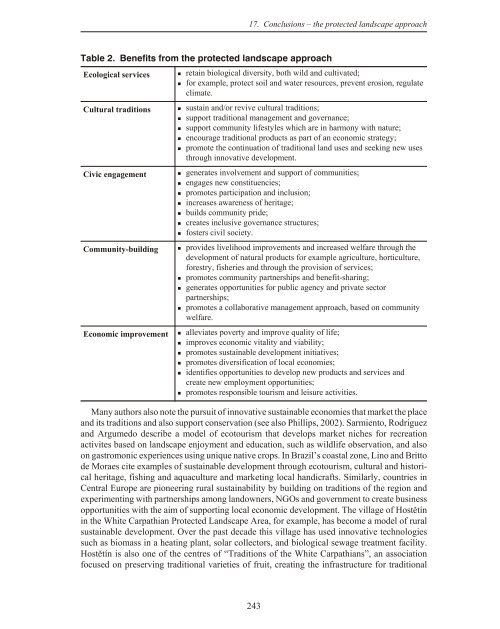The Protected Landscape Approach - Centre for Mediterranean ...
The Protected Landscape Approach - Centre for Mediterranean ...
The Protected Landscape Approach - Centre for Mediterranean ...
Create successful ePaper yourself
Turn your PDF publications into a flip-book with our unique Google optimized e-Paper software.
17. Conclusions – the protected landscape approach<br />
Table 2. Benefits from the protected landscape approach<br />
Ecological services retain biological diversity, both wild and cultivated;<br />
<strong>for</strong> example, protect soil and water resources, prevent erosion, regulate<br />
climate.<br />
Cultural traditions sustain and/or revive cultural traditions;<br />
support traditional management and governance;<br />
support community lifestyles which are in harmony with nature;<br />
encourage traditional products as part of an economic strategy;<br />
promote the continuation of traditional land uses and seeking new uses<br />
through innovative development.<br />
Civic engagement generates involvement and support of communities;<br />
engages new constituencies;<br />
promotes participation and inclusion;<br />
increases awareness of heritage;<br />
builds community pride;<br />
creates inclusive governance structures;<br />
fosters civil society.<br />
Community-building provides livelihood improvements and increased welfare through the<br />
development of natural products <strong>for</strong> example agriculture, horticulture,<br />
<strong>for</strong>estry, fisheries and through the provision of services;<br />
promotes community partnerships and benefit-sharing;<br />
generates opportunities <strong>for</strong> public agency and private sector<br />
partnerships;<br />
promotes a collaborative management approach, based on community<br />
welfare.<br />
Economic improvement alleviates poverty and improve quality of life;<br />
improves economic vitality and viability;<br />
promotes sustainable development initiatives;<br />
promotes diversification of local economies;<br />
identifies opportunities to develop new products and services and<br />
create new employment opportunities;<br />
promotes responsible tourism and leisure activities.<br />
Many authors also note the pursuit of innovative sustainable economies that market the place<br />
and its traditions and also support conservation (see also Phillips, 2002). Sarmiento, Rodriguez<br />
and Argumedo describe a model of ecotourism that develops market niches <strong>for</strong> recreation<br />
activites based on landscape enjoyment and education, such as wildlife observation, and also<br />
on gastromonic experiences using unique native crops. In Brazil’s coastal zone, Lino and Britto<br />
de Moraes cite examples of sustainable development through ecotourism, cultural and histori -<br />
cal heritage, fishing and aquaculture and marketing local handicrafts. Similarly, countries in<br />
Central Europe are pioneering rural sustainability by building on traditions of the region and<br />
experimenting with partnerships among landowners, NGOs and government to create business<br />
opportunities with the aim of supporting local economic development. <strong>The</strong> village of Hosttín<br />
in the White Carpathian <strong>Protected</strong> <strong>Landscape</strong> Area, <strong>for</strong> example, has become a model of rural<br />
sustainable development. Over the past decade this village has used innovative technologies<br />
such as biomass in a heating plant, solar collectors, and biological sewage treatment facility.<br />
Hosttín is also one of the centres of “Traditions of the White Carpathians”, an association<br />
focused on preserving traditional varieties of fruit, creating the infrastructure <strong>for</strong> traditional<br />
243

















